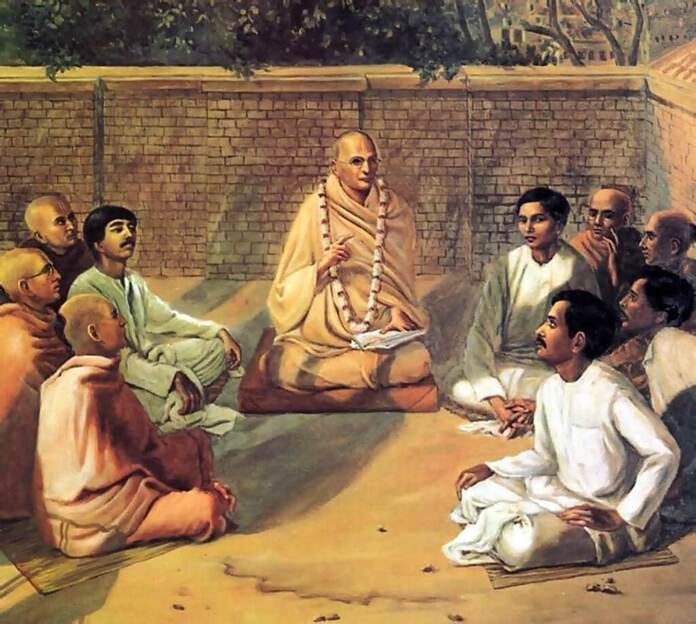Srila Bhaktisiddhanta Sarasvati Thakura

Bhaktisiddhanta Sarasvati Thakura Goswami Maharaja Prabhupada (1874-1937) the spiritual master of His Divine Grace A.C. Bhaktivedanta Swami Prabhupada, and thus the spiritual grandfather of the present day Krishna consciousness movement. A powerful preacher, he founded sixty four missions in India; The transcendentally empowered son of Srila Bhaktivinoda Thakura, Srila Bhaktisiddhanta Sarasvati Thakura appeared in this world on February 6, 1874. His father was deputy magistrate of Jagannatha Puri in Orissa at this time. Srila Bhaktivinoda Thakura had been very concerned about unauthorized pseudo-Vaishnavas who were usurping the pure teachings of Lord Caitanya Mahaprabhu, and therefore had begun a revival of the Sankirtan mission.
Though very busy with his profession, he wrote profusely about all aspects of Krishna consciousness. He prayed constantly for someone to boldly preach his writings. Srila Bhaktivinoda Thakura's prayers were answered in Srila Bhaktisiddhanta Sarasvati Thakura. When he was six months old, the Ratha-yatra festival of chariots was held in Puri. Lord Jagannatha's chariot stopped in front of Srila Bhaktivinoda's house, which was on the main road between the temple and the Gundica mandira. The chariot stayed there for three days.
On the third day, Srila Bhaktisiddhanta's mother brought the child out to see the Lord. The pujaris picked him up and put him on the cart. He crawled to the base of Lord Jagannatha, touching His lotus feet. Simultaneously a garland fell from the neck of the Lord and landed around the child. The pujaris exclaimed that this child was especially blessed by the Lord. The boy grew up to be a great scholar in many fields of learning. But when he reached twenty-two, he left his studies at college, vowing to never take to householder life. For three years, Srila Bhaktisiddhanta Sarasvati Thakura held the post of raja-pandita (royal scholar) of the Vaishnava king of Tripura. Thereafter he took initiation from Srila Gaurakishora dasa Babaji.
Srila Gaurakishora was a Vaishnava renunciate who had fully absorbed himself in the worship of Krishna at Vrindavana for a long time. Then he settled at the holy city of Navadvipa on the bank of the Ganges. By this time Srila Bhaktivinoda Thakura had retired from his government work and was worshiping Lord Krishna in a small house near Navadvipa, at Godruma. Every day he gave Srimad- Bhagavatam class there. Srila Gaurakishora used to attend these classes. Srila Bhaktivinoda Thakura told his son, Srila Bhaktisiddhanta Sarasvati Thakura, to accept Srila Gaurakishora as his initiating spiritual master. He received the name Varshabhanavi-devi-dayitaya dasa.
Thereafter Srila Bhaktisiddhanta Sarasvati Thakura gave up all other activities to chant 194 rounds daily for seven years. He stayed in a kutira (hut) but did not take time to repair the roof; if it rained, he just used an umbrella. In 1918 he opened the first center of the Gaudiya Mission in Ultadanga Road in Calcutta. He was then forty-four. All across India he established Lord Caitanya's teachings as the most excellent spiritual philosophy. He started his mission in the midst of war and political agitation for national liberation. He was uncompromising in his disregard of such mundane concerns. The most important thing is to invoke the spirit of devotion to the Supreme Lord; this concern lies far above any material consideration. Many leaders objected that he was diverting too many young men from India's national interests, but he paid them no heed.
In this period, Srila A.C. Bhaktivedanta Swami Prabhupada visited Srila Bhaktisiddhanta Sarasvati Thakura on the rooftop at Ultadanga Road. Srila Prabhupada, at that time known as Abhay Caran De, was an adherent of Gandhi's svaraja movement. Srila Bhaktisiddhanta Sarasvati Thakura convinced him in just one sitting of the vital necessity of Lord Caitanya's mission over everything else. Srila Bhaktisiddhanta Sarasvati Thakura departed this world in 1936. Two weeks before leaving his body, he instructed Srila Prabhupada to introduce the Sankirtan mission to the Western world.